Abstract
The performance of water heating systems must be evaluated considering energy consumption and efficiency in storing and distributing hot water, together with building and climate characteristics. This work aims to analyse the performance of different water heating systems compared to electric showers, which are widely used in Brazil. Systems with individual gas heaters and solar heaters with electric backup and gas backup were analysed in multi-family buildings. In addition, the influence of thermal insulation of hot water pipes was verified. The analyses were conducted using the EnergyPlus programme, considering three Brazilian cities with different climates: Curitiba, Brasília, and Belém. The results showed that solar heaters are a low primary energy consumption alternative, especially if combined with gas heaters. However, electric showers are the most efficient option for larger buildings and cold-climate cities, where thermal losses in distribution are more significant. Monthly, an electric shower can save up to 1.82 kWh/m2 of electricity compared to a solar heating system with an electric backup. The insulation has a limited influence on the performance of short-length pipes (temperature difference less than 0.3 °C in the instantaneous gas system). For longer pipes, the absence of insulation significantly reduces the shower temperature (up to 2.47 °C in solar heating systems), mainly in cold-climate locations. It is concluded that the most suitable water heating system should be determined according to the climate and characteristics of the buildings, such as the size and length of the pipe.
1. Introduction
Water heating corresponds to one of the main forms of energy consumption in households in several countries [1], and its performance is mainly influenced by the climatic conditions, the energy source used, and the type and arrangement of the system [2]. In Brazil, the electric shower is the third most common equipment, with the largest share in electricity consumption in the residential sector, accounting for about 15% of the sector’s consumption [3]. According to [4], 37.5% of Brazilian households use electricity to heat water for showers, while less than 2.0% use gas or solar energy.
To reduce electricity consumption and promote clean energy, several policies worldwide encourage the use of more efficient systems and renewable energy sources for water heating, such as financial subsidy policies, tax credits, and even mandatory policies [5]. In Brazil, some cities [6] and states [7] already have laws making it mandatory to use solar heating to meet a minimum proportion of hot water demand. Solar heating systems can reduce the maximum peak demand compared to electric showers, which highly represent the peak demand in Brazil. A study showed that solar heating systems would provide more than a 60% reduction in the peak demand if these systems were applied in new housing developments in Brazil, improving the national electric power generation system [8]. In addition, several authors have indicated solar energy as an alternative to reduce primary energy consumption for hot water generation [9,10]. However, using solar systems in multi-family buildings may not be as efficient as for single-family homes. In tall buildings, the greater that the number of floors is, the higher that the ratio is between the total hot water demand and the perimeter of the building. In such cases, the roof area may not be sufficient for the collectors needed to meet the demand [11]. Especially in climates with significant variations in solar radiation, solar heating systems may not be suitable all year. A backup system, such as gas, should be considered in these cases. In turn, the efficiency of the backup system depends on the temperature difference between the cold and the hot water [12].
Furthermore, not only hot water generation should be considered in water heating system performance and efficiency analyses. Several authors have shown that thermal losses in hot water storage and distribution and electricity consumption for water circulation influence the system performance and the water and energy consumption [1]. According to Gu [13] and Bøhm [14], many studies and standards focus on the efficiency of hot water generation but do not consider the thermal losses in the pipes. These losses must be considered to avoid wasting water and energy and to increase the efficiency of the system as a whole. Thermal losses can be reduced by insulating the pipes and reducing the temperature difference between the water and the environment [15]. According to Atienza-Márquez et al. [16], poor thermal insulation and deterioration over time can be responsible for significant thermal loss throughout hot water distribution pipes. Lutz [17] estimated that 20% of household hot water is wasted. After a hot water shower, the hot water in the pipes loses heat, so the water temperature decreases. When the system is activated again, the water in the pipe is at a lower temperature than expected and is discarded until the water reaches the desired temperature [18]. In addition to the waste of energy to reheat a quantity of water that had already been previously heated, there is the waste of drinking water. These previous works raised questions about the efficiency of water heating systems with significant distribution losses compared to electric systems, with which no distribution losses occur [19].
It is important to note that the energy lost through heat transfer in the pipes can significantly increase energy consumption for hot water generation, but it is not a rule. As shown in the NAHB study [20], the reduction in heat losses due to thermal insulation will not necessarily reduce energy consumption because the efficiency of the distribution system is influenced by the temperature of the hot water and the environment. In addition, even with insulation, there will be some heat losses. In addition, the time between uses of the shower impacts the thermal losses of the system because, if the shower is used twice in a row, the remaining hot water in the pipes is used again before its temperature decreases.
The distance between the heater and the shower also influences energy losses because the longer that the pipes are, the greater that the volume of water is that will cool in the pipes when the system is being used. Furthermore, it takes longer for the heated water to reach the point of use. Therefore, cold water is wasted until hot water arrives [21]. In this context, works such as Wendt et al. [22] and Bøhm [14] recommended that hot water pipes be as short as possible. Ioris and Ghisi [23] suggested installing an automated system to save cold water in one or two showers per flat in a multi-family building. The authors found that these systems could save 2.13 litres and 4.14 litres of water per shower in cases of one and two systems per flat, respectively. In addition, intelligent techniques (e.g., artificial neural networks and vector machines) can be used to predict heaters’ performance [24].
The performance of alternative water heaters has been investigated in the literature, e.g., photovoltaic-powered electric water heaters [25], photovoltaic panels combined with thermal collectors [26], solar-assisted heat pump water heaters [27], biogas from building waste [28], biomass and geothermal energy heaters [29], and other cogeneration systems [30]. However, studies analysing the thermal performance of these alternative systems compared to those using only electricity have been limited. In addition, in some works, the electric systems had water storage [31], which is a system different from the electric showers (with instantaneous heating) widely used in Brazil. Thus, studies evaluating the efficiency of alternative systems compared to electric showers in different climatic and building conditions are still needed. Furthermore, Brazilian laws and regulations present systems that use clean energy for water heating, such as solar energy, as more energy-efficient alternatives. However, Brazil has an extensive territory and a great variety of climates. The north and northeast regions have hot climates and less need for hot water compared to the south and southeast, which have milder climates. Thus, performance evaluations must consider climate characteristics and thermal losses in the pipes, as they can influence the efficiency of these systems. This study aims to compare the primary energy consumption and thermal losses of different water heating systems for showering during the operation phase in multi-family residential buildings, considering three different climatic contexts.
2. Methodology
2.1. Climatic Conditions
As the climatic conditions of the building location influence the performance of the water heating system, the study was carried out for three Brazilian cities with different climates: Curitiba, Brasília, and Belém. Figure 1 shows the average monthly temperatures of the cities analysed throughout the year.
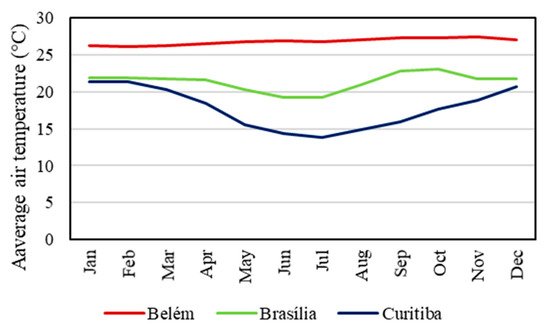
Figure 1.
Average monthly temperature of the cities analysed. Source: Based on [32].
Curitiba is the coldest city, with an annual average of 17.8 °C, and Belém is the hottest city, with an annual average of 26.8 °C. In Brasília, the annual average temperature is 21.4 °C. Curitiba has a latitude of −25°25′, Brasília’s is −15°46′, and Belém’s is −01°27′.
2.2. Characterisation of the Building and Water Heating Systems
Two multi-family buildings with four flats per floor were considered, one with four floors and another with 12 floors (Figure A1 in Appendix A). The envelope of the buildings consists of ceramic masonry walls with a mortar coating. Concrete slabs were used for the floors and roofs. In models with solar heating, the collectors are installed on the roof. The windows are composed of ordinary glass. Natural ventilation was modelled according to [33]. Both have the same floor plan with one bathroom, two bedrooms, and an area of approximately 60 m2. It was considered that each flat has three residents, and hot water is used only in showers. Thus, hot water was not analysed at other points, such as kitchen and bathroom taps, hygienic showers, or washing machines.
The water heating systems analysed were the most commonly used in multi-family dwellings in Brazil: an electric shower, an instantaneous gas heater in each flat, a central solar heating system with electric backup, and a central solar heating system with gas backup (Table 1). The influence of thermal insulation was investigated in the centralised systems with instantaneous gas heaters and solar heating with gas backup. The sizing of the systems aimed to meet the determinations of the Technical Regulation of the Quality for the Energy Efficiency Level of Residential Buildings [33] and Brazilian technical standards and was described in [34]. For electric showers, a flow rate of 3 L/min was considered, according to existing models of electric showers. For the solar and gas heating systems, the type of shower used has a flow rate of 12 L/min, according to Brazilian Standard NBR 5626 [35]. Table A1 in Appendix A shows the characteristics of the instantaneous individual systems (one heater per flat). These systems operate without a hot water tank.

Table 1.
Water heating systems analysed.
Solar heating was considered a collective system that serves all flats, sized to meet 70% of the annual demand, which is the minimum solar fraction to obtain a high-efficiency level according to [33]. For solar heaters with electric backup, an electric heating element was considered inside the hot water tank, the power of which corresponds to the boiler’s available power. For the solar heater with gas backup, the solar heating and the collective gas heaters were sized independently. The gas system was sized to meet 100% of the demand, as it is required to provide sufficient hot water on cloudy days. Table A2 in Appendix A presents the characteristics of the gas central heating system adopted.
Table A3 in Appendix A shows the characteristics of the solar heating system of the four-storey building. For the system with electric heating element in the water tank, the power of the tank model adopted is 10,000 W.
The data used in the design for the 12-storey building is shown in Table A4 (Appendix A). Although the number of inhabitants is three times greater than in the four-storey building, the calculated collector area is approximately 2.3 times greater because the occupancy factor for calculating daily hot water consumption varies according to the number of flats. The electric heating element of the tank models adopted is 15,000 W.
2.3. Computer Simulations
Computer simulations over one year were carried out in EnergyPlus software, version 8.2, to analyse the energy consumption of the systems. The showers were modelled with the WaterUse:Equipment object. The inputs included shower temperatures, pattern schedules, and the shower flow rate. The showers were inserted into the model circuit using the WaterUse:Connections object for each floor, with each set containing four showers.
The desired hot water temperatures at the consumption points are shown in Table 2. Shower temperatures (hot water) were lower in summer and higher in winter. The monthly cold water temperature was considered equal to the average monthly air temperature minus 2 °C, according to [33]. Regarding the use pattern of showers, one shower per day per resident lasting 10 min was considered. In instantaneous individual heating systems, the cold and hot water temperatures are fixed since the shower time does not influence consumption. Thus, three showers were considered during the morning period for the gas heater and electric shower systems. For central solar heating, the showers were distributed among the flats, considering some flats with a shower in the morning and others in the evening so that, on all floors, showers occur in all periods.

Table 2.
Shower temperatures considered in the simulations.
To simulate the instantaneous devices (electric showers and instantaneous gas heaters), the WaterHeater:Mixed object was used. The tank volume field was considered the internal volume of the heater, as there is no storage. The heater control type was modulated, in which the power of the heaters varies between the maximum and minimum capacities.
The solar heating system simulation model consists of solar collectors, hot water tanks, and an auxiliary heating system. The objects SolarCollector:FlatPlate:Water and SolarCollectorPerformance:FlatPlate were used to define the collectors. Collector models available in EnergyPlus with an optical efficiency factor and overall loss coefficient close to those of the collectors sized (obtained from [36]) were used. Table A5 in Appendix A shows the coefficients of the efficiency equation. The collectors’ area, position, inclination, and orientation were modelled as a shading element.
In these systems, the storage volume was divided into two tanks. The second tank has supplementary heating (a tank with an electric heating element or connected to the gas heaters). The tank for hot water storage was designed as a vertical tank, providing higher efficiency through stratification. The setpoint temperatures of the tanks are described in Table 3. Since the thermal losses in collective systems are more significant than for individual systems, the adopted setpoint temperatures are higher than the shower temperatures to meet the desired temperature on all floors.

Table 3.
Setpoint temperatures of the tanks in solar heating systems with electric and gas backup.
For electric showers, the Pipe:Adiabatic object was used to model the pipes since there are no hot water pipes (i.e., the water is heated directly in the shower). In central systems, the Pipe:Indoor object was used. This object simulates the heat transfer between the pipes and the thermal zone in which each section of pipe is located.
Adaptations of the water heating systems geometry were carried out to make them compatible with the EnergyPlus resources since the programme version used does not allow for the design of complex water heating systems with identical configurations to those of the actual buildings. The systems were sized as open circuits. However, the programme simulates only systems with closed circuits.
2.4. Primary Energy Consumption
The annual primary energy consumption was used to compare the efficiency of systems using different energy sources. The primary energy consumption is given by multiplying the annual final energy consumption (obtained from the simulations) by the conversion factor from final to primary energy for the energy source analysed, according to Equation (1). For liquefied petroleum gas, a conversion factor of 1.10 was adopted [37]. A factor of 1.46 was considered for electricity, calculated using the same method as [37] but using data published by [38]:
where PE is the annual primary energy consumption (kWh), FE is the annual final energy consumption (kWh), and CF is the primary energy conversion factor (dimensionless).
PE = FE × CF
2.5. Thermal Losses in the Pipes
The influence of thermal insulation in the piping for hot water distribution was analysed through simulations considering piping with and without insulation for the instantaneous gas system and the central solar system with gas backup. For the systems with an instantaneous gas heater, for each flat, the simulation model considers the pipes from the heater (located in the laundry) to the shower (in the bathroom). For the solar system, the collectors and tanks are installed on the roof. In these cases, the pipes between the tank and the shower were considered, i.e., the vertical pipe that distributes water from the tank to the floors and the horizontal pipes in each flat.
For hot water distribution, polypropylene random copolymer (PP-R) pipes with and without thermal insulation were considered. The insulating material used was expanded polyethylene with 1-cm thickness and thermal conductivity of 0.035 W/mK, meeting the requirements of [33]. It was considered that the pipes and heaters exchange heat with the thermal zones of the simulation model. The piping of the primary solar heating circuit (between the collectors and the tank) is made of copper with the same thermal insulation used in the secondary system. The insulation of these pipes was kept in all simulated cases due to the high thermal conductivity of copper and because these pipes are located in an external environment.
Water temperatures at various points in the circuit were obtained in the simulations to analyse the influence of thermal insulation on the performance of the system. The temperatures at the pipe outlet of the systems with and without insulation were compared, and for the central system, the temperatures at the pipe outlet on the first and last floors were analysed.
For the system with an instantaneous gas heater, the variation in the water temperature at the end point of the pipe throughout the day was checked to determine whether the insulation was sufficient to maintain the water at the desired temperature and avoid the disposal of cold water until the arrival of hot water when the shower is turned on. Temperatures at the time of showering were also compared to verify the reduction in shower water temperature caused by thermal losses in the pipes and the impact of thermal insulation.
3. Results
This section presents the results of the final and primary energy consumption of the water heating systems, as well as the thermal losses in the pipes.
3.1. Final Energy Consumption
The final energy consumption of water heating systems, separated into systems using electricity and systems using gas, is presented in this section.
3.1.1. Systems Using Electricity
Figure 2 shows the final energy consumption (electricity) of the systems that use electricity (electric shower and solar heater with electric heating element in the tank) in the four-storey building in the three cities analysed.
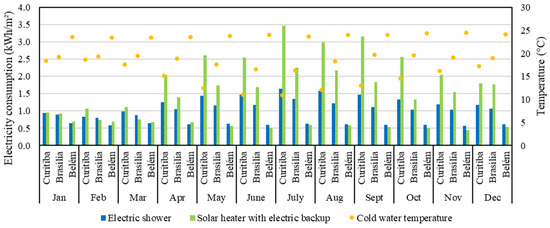
Figure 2.
Final monthly energy consumption of the systems using electricity for a four-storey residential building.
It is important to emphasise that the flow rate of the showers in these two systems is not the same, and consequently, the volume of water to be heated daily is different. It is noted that, even with this difference in volumes, in the summer months and in cities with a warm climate, the consumption of electricity for these two types of heating is quite close. Although the solar heating system heats a greater volume of water (due to the greater flow rate), it meets a greater demand for hot water, i.e., without using the electric backup. For the months with colder temperatures, solar heating with an electric boiler showed higher energy consumption. In these months, the solar system meets a lower demand for hot water, and it is necessary to use the electric heating element of the tank. These results agree with [39,40], who found higher electricity energy consumption during the year in single-family houses in cold cities than in hot cities. Bessa and Prado [40] also highlighted that, despite the lower electricity consumption for solar heating systems with electric backup in the tank in hot cities compared to cold cities, the hotter cities have a small reduction in CO2 emissions. Both CO2 emissions and electricity consumption depend on the solar fraction and cold-water temperature. Thus, reducing CO2 emissions should also be considered when formulating incentive policies, considering the higher cost of installing solar heating systems.
The electric shower, an instantaneous system, only consumes energy when the hot water is used. In the accumulation system, the electric heating element is activated each time the water in the tank reaches a predetermined minimum temperature, resulting in energy consumption when the showers are unused. In addition, on colder days, thermal losses in the tanks and pipes are higher. These losses do not occur in the system with an electric shower since the water is heated directly at the consumption points.
Figure 3 shows the final energy consumption of the systems in the 12-storey building in each climate context.
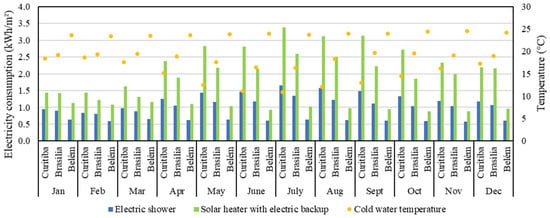
Figure 3.
Final monthly energy consumption of the systems using electricity for a 12-storey residential building.
Solar heating with an electric boiler showed higher energy consumption than the electric shower in all cases, and the difference in monthly consumption between the two systems analysed is more significant than for the four-storey building. As a larger system, the centralised system has greater thermal losses, increasing energy consumption.
Comparing the electricity consumption between the lower-flow electric shower with the higher-flow solar heating system with an electric backup in the tank, the results found in the four-storey building are similar to those of [39] in a single-family house. That is, with the electric shower, lower consumption was found in cold months and cities compared to solar heating with electric backup. In hot months and cities, electric showers result in lower or quite close consumption compared to solar systems with electric backup. In contrast, in the 12-storey building, the solar heating system with electric backup showed greater electricity consumption in all months and cities analysed, emphasising the influence of building size in defining the suitable water heating system type.
3.1.2. Systems Using Gas
Figure 4 shows the final energy consumption of the systems with gas heaters and solar heating with gas backup in the four-storey building, with thermal insulation in the pipes.
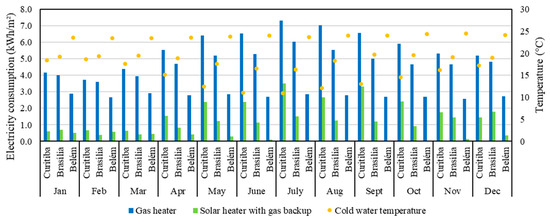
Figure 4.
Final monthly energy consumption of the systems using gas for a four-storey residential building.
In all months and cities, solar heating with gas backup presented lower energy consumption than heating with gas heaters. As the amount of water heated is the same in both cases, solar energy provides significant fuel savings. Even if more thermal loss occurs in the collective central system than in the individual gas system, solar energy is still advantageous due to the longer pipe length. The water heating provided by the solar system reduces the water temperature for the gas heater [12].
Figure 5 shows the final energy consumption for the systems in the 12-storey building.
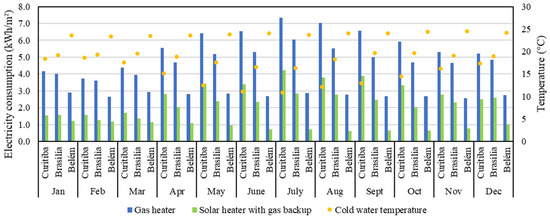
Figure 5.
Final monthly energy consumption of the systems using gas for a 12-storey residential building.
In the 12-floor building, the difference between the consumption of the solar system and the individual gas heating is smaller, and the savings are less significant. The centralised system is larger, and thermal losses are more significant than in the four-storey building. Nevertheless, solar heating has lower energy consumption. These results corroborate [41], who found that up to a 56% monthly reduction can be achieved by replacing a conventional gas water heater with a solar water heater with gas backup in a single-family house in Pakistan.
3.2. Primary Energy Consumption Analysis
Figure 6, Figure 7 and Figure 8 show the annual primary energy consumption of the four water heating systems analysed. Among the cities evaluated, the highest consumption was observed in Curitiba (the coldest city), regardless of the water heating system. The greater difference between the cold and the hot water temperatures impacts the energy consumption of the electric shower, gas heater, and solar heater backup systems [12].
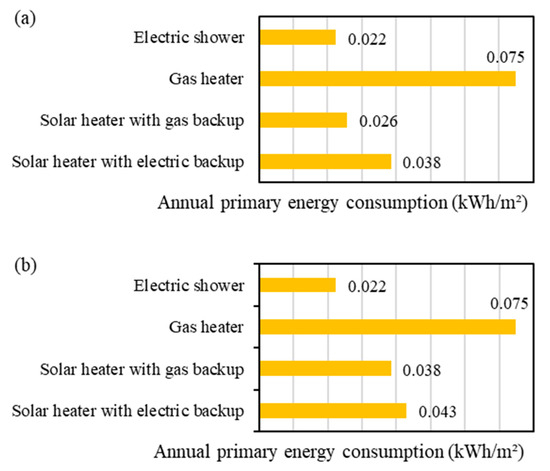
Figure 6.
Annual primary energy consumption for water heating in Curitiba in the (a) four and (b) 12-storey buildings.
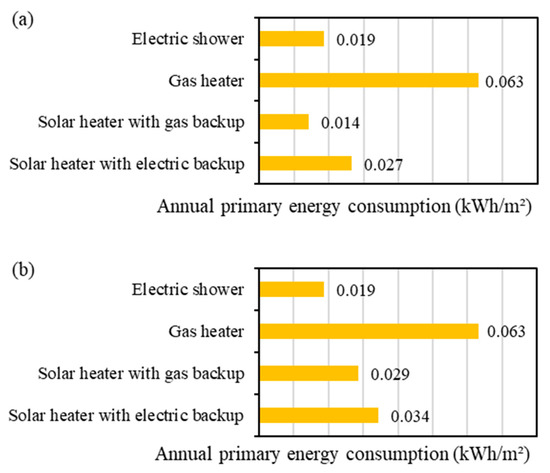
Figure 7.
Annual primary energy consumption for water heating in Brasília in the (a) four and (b) 12-storey buildings.
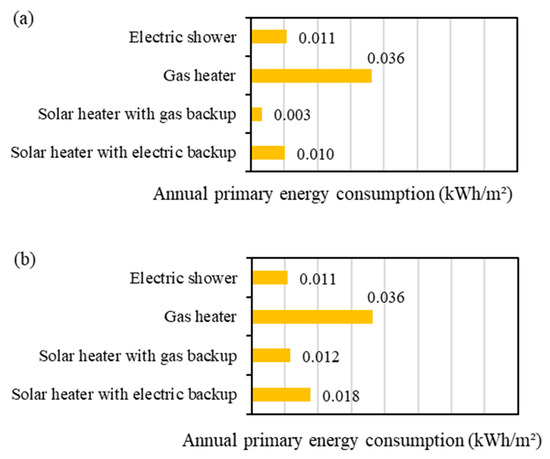
Figure 8.
Annual primary energy consumption for water heating in Belém in the (a) four and (b) 12-storey buildings.
In all cases, the instantaneous gas heater had the highest consumption. Similar results were found in [39], which compared gas heaters with electric showers and solar heaters with electric backup (with water storage temperature close to shower temperature) in a single-family house. In addition to the lower gas conversion factor in relation to electricity, the flow rate was considered higher in this system, using more energy to heat the water.
Solar heating provides primary energy savings, especially when combined with gas backup, which has a lower conversion factor value than electricity. In the four-storey building, when the solar heater is backed up by gas heaters, the conversion factor of which is lower, the primary energy consumption is lower than that of the electric shower, except for Curitiba. The central system has a higher flow rate in the showers than the electric shower and consequently a greater amount of water to be heated, in addition to thermal losses in storage and distribution. However, using solar energy combined with a fuel with a lower primary energy conversion factor means that total energy consumption is lower in Brasília and Belém. In Curitiba, primary energy consumption is lower for the electric shower than for the solar heater with gas backup. This city has a colder air temperature than the other locations, increasing the thermal losses in the hot water distribution system. Thus, using individual systems in cold climates may be more efficient than centralised and storage systems. These findings reiterated that the environmental temperature should be considered in thermal loss analysis, in addition to thermal insulation and pipe length [20]. In Belém, which has a warm climate, thermal losses are not as critical, and solar heating has a consumption close to the electric shower, even when an electric heating element performs the backup. With gas backup, consumption is up to 70% lower than the electric shower. Solar energy is an efficient option for locations with higher air and cold-water temperatures and good solar radiation incidence, even with centralised systems.
On the other hand, in larger systems, such as the 12-storey building, thermal losses in centralised systems have a greater impact on energy consumption, even for hot climate cities. The electric shower showed lower energy consumption than the solar systems, even for Belém. This finding showed that electric showers may be more efficient in buildings with longer pipes since no thermal losses occur in these systems [19]. The instantaneous gas heater has the highest primary energy consumption, even with a shorter pipe length between the heater and the shower than the centralised systems. These systems have showers of the same flow rate, and the volume of water heated is the same. It can be seen that the use of solar energy offsets the thermal losses of the system, resulting in lower energy consumption even for large systems.
Although the primary energy consumption of the electric shower and solar heating are close in some cases, the volume of heated water is greater in the solar system than in the electric shower, which has a lower flow rate shower. If a lower flow rate shower were used in the central system, the energy consumption would be lower, and solar heating could be the most advantageous alternative. The same is true for the instantaneous gas heater: with lower flow rate showers, the final energy consumption would be lower, and due to the lower conversion factor, the primary energy consumption of the gas heater could be reduced.
Many public policies encourage the replacement of electric showers with other systems. However, it was noted that the electric shower provided one of the lowest primary energy consumption rates among the systems evaluated. It is observed that systems with higher flow rate showers, which lead to higher levels of showering comfort, have higher primary energy consumption. However, it is essential to emphasise that, as shown by [8,42], electric showers result in higher electricity consumption at peak hours since energy use occurs during showering.
3.3. Analysis of Thermal Losses in the Pipes
This section shows the results of thermal losses in pipes of instantaneous gas heaters and solar heating with gas backup systems with and without insulation.
3.3.1. Instantaneous Gas Heater
For the individual gas heater, there was no significant increase in energy consumption due to the absence of thermal insulation because the user defines the temperature setpoint in the heater and not in the shower, only regulating the temperature in the shower if it is warmer than desired. In this way, there is a reduction in shower temperature in cases without thermal insulation.
Figure 9 and Figure 10 show the temperature variation at the pipe outlet for the system with instantaneous gas heaters. The results are shown for Curitiba and Belém, which have the most extreme climates among the cities analysed. For Curitiba, winter and summer days were chosen, as air temperatures vary according to the seasons. For Belém, where the climate is hot throughout the year, only one day is presented, as the same behaviour was observed on the other simulated days. Table 4 and Table 5 show the outlet temperatures of the pipe at the time of the shower.
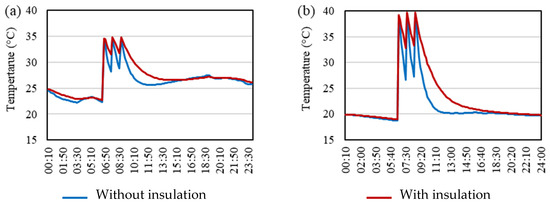
Figure 9.
Temperature variation at the pipe outlet with and without thermal insulation for the instantaneous gas heater in Curitiba on (a) 15 February and (b) 15 August.

Figure 10.
Temperature variation at the pipe outlet with and without thermal insulation for the instantaneous gas heater in Belém on 15 February.

Table 4.
Temperature at the outlet of the hot water pipe at shower time for the instantaneous gas heater in Curitiba.

Table 5.
Temperature at the outlet of the hot water pipe at shower time for the instantaneous gas heater in Belém.
Due to thermal losses in the pipes, the shower temperature can be up to 1 °C lower than the shower temperature set on the heater. The water reaches a slightly higher temperature with thermal insulation, but the difference with and without insulation does not exceed 0.3 °C. It can be seen that the most significant influence of thermal insulation is not on the temperature at the time of showering but on the time that it takes for the standing water in the pipe to cool. When the shower is not in use, and the water is standing in the pipe, it cools faster when there is no thermal insulation. Suppose that one person takes a shower shortly after another, and the pipe is insulated. In that case, the water will be at a temperature closer to the desired one, and less water will be wasted until the hot water arrives. However, suppose that the showers are taken with a longer interval between them (e.g., in the morning and evening). In that case, the water in the shower is almost at the same temperature with or without thermal insulation. In these cases, the thermal losses result in the discarding of cold water until the arrival of hot water, causing higher water consumption [18].
3.3.2. Solar Heating with Gas Backup
Table 6, Table 7 and Table 8 show the temperatures at shower time in the 12-storey building at the inlet of the hot water distribution pipe (outlet of the tank) and the outlet point of the vertical pipe of the 12th floor (closest to the heater) and first floor (furthest from the heater). The difference between the pipe inlet temperature and the outlet temperature at the vertical pipe of each floor was also indicated. When the temperature difference exceeds 2 °C, the cells are marked in orange; when the difference is between 1 °C and 2 °C, they are marked in green; and for differences less than 1 °C, the cells are marked in blue. The results for Curitiba and Belém are shown here for the same days analysed in Section 3.3.1.

Table 6.
Water temperature at different points of the pipes in the 12-storey multi-family building in Curitiba (15 February).

Table 7.
Water temperature at different points of the pipes in the 12-storey multi-family building in Curitiba (15 August).

Table 8.
Water temperature at different points of the pipes in the 12-storey multi-family building in Belém (15 February).
As expected, the longer that the pipe length is, the higher that the water temperature difference is between the inlet and outlet points. Due to the longer pipe length and, consequently, higher thermal loss, it is seen that thermal insulation is required for longer distances. In most cases, the difference between the inlet and outlet temperature on the 12th floor does not exceed 1 °C, even without insulation. On the other hand, the differences between the inlet and outlet water temperatures for the first floor are quite significant, especially for Curitiba, which has a climate colder than Belém.
The temperature difference between the inlet and outlet of the pipes is higher in the first shower of each time range. When the showers occur one right after the other, the water and pipes are already heated, and the temperature difference is smaller. The most remarkable difference occurs in the first shower of the morning. Even with thermal insulation, the temperature difference can reach 8.15 °C.
For Curitiba, the temperature difference in winter can reach more than 10 °C for the first shower of the morning when there is no thermal insulation. For the cold climate, it can be seen that the 1 cm-thick insulation is not enough to prevent thermal losses, and even with the insulation, the temperature difference ranged from 1.41 °C to 8.15 °C. For the hot climate of Belém, thermal losses are still perceived for long distances, even with the insulation (up to 4.30 °C). Thus, although the insulation improves performance, in cold cities, it is necessary to use thicker insulation because the losses are still significant.
While some studies of thermal losses in pipelines have shown a significant difference in losses with and without insulation [16,41], other works [20] have shown that the efficiency of the system as a whole depends not only on materials and pipe lengths but also on user habits and that reducing thermal losses does not necessarily means energy savings. This finding can also be evidenced in this research, in which a greater temperature difference between the heater and the hot water outlet was perceived in the first shower than when subsequent showers occurred. This significant temperature difference in the first shower is perceived even with thermal insulation.
4. Conclusions
This work analysed different water heating systems in multi-family residential buildings in three Brazilian cities with different climates. Based on our results, the following conclusions were drawn.
- Regarding final energy consumption, the electric shower is an efficient alternative for large multi-family buildings, as it does not present thermal losses in the storage and distribution of hot water. The monthly electricity consumption for water heating in a multi-family building with electric showers can be up to 1.82 kWh/m2 lower than with a solar heating system with an electric backup.
- Solar heating systems with a heater inside the tank (electric backup) consume a large amount of energy due to thermal losses and the need to keep the water temperature in the tank always within a pre-set temperature range. Automation solutions that allow the system to be controlled not only by temperature limits but also by pre-set schedules can be an alternative to reduce consumption and improve efficiency.
- The different shower flow rates influence both potable water and energy consumption. One of the reasons for the significant difference in energy consumption of systems using electric showers compared to other systems is the lower flow rate adopted for the shower and, consequently, the amount of water to be heated. Thus, for existing shower flow rates in the Brazilian market, replacing electric showers with other systems may not be adequate under energy saving aspects.
- Thermal insulation has a negligible impact on user comfort and energy consumption for short pipe lengths (the temperature difference with and without insulation in the instantaneous gas system is less than 0.3 °C). However, for longer lengths, such as in collective systems of multi-family buildings, using insulation improves performance. In the solar heating system with gas backup, the temperature differences between the water inlet and outlet for the first floor can be up to 8.15 °C and 10.33 °C with and without insulation, respectively.
- To improve the performance of heating systems, it is recommended to use thermal insulation in long pipes and pre-set schedules to control solar heating systems. Taking showers in sequence can avoid wasting water and energy when solar and gas heaters are used.
This work showed that the efficiency of water heating systems varies according to climate and pipe lengths, so their evaluation should be carried out considering these factors.
Author Contributions
Conceptualisation, J.M.S. and E.G.; methodology, J.M.S.; validation, J.M.S. and T.P.S.; formal analysis, J.M.S.; investigation, J.M.S. and T.P.S.; data curation, J.M.S.; writing—original draft preparation, J.M.S.; writing—review and editing, T.P.S. and E.G.; visualisation, J.M.S. and T.P.S.; supervision, E.G. All authors have read and agreed to the published version of the manuscript.
Funding
This research received no external funding.
Data Availability Statement
Data sharing is not applicable to this article.
Conflicts of Interest
The authors declare no conflict of interest.
Appendix A
This appendix shows the characteristics of the building and the water heating systems.
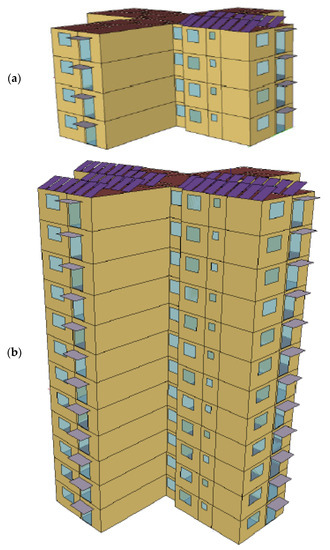
Figure A1.
Building model with (a) four and (b) 12 floors.

Table A1.
Characteristics of individual instantaneous heating systems.
Table A1.
Characteristics of individual instantaneous heating systems.
| Heating System | City | Flow Rate (L/min) | Nominal Power (kW) | Efficiency (%) 1 |
|---|---|---|---|---|
| Electric shower | Curitiba | 3 | 6.5 | 95 |
| Brasília | 3 | 5.2 | 95 | |
| Belém | 3 | 3.2 | 95 | |
| Instantaneous gas heater | Curitiba | 12 | 30.9 | 85 |
| Brasília | 12 | 25.1 | 84 | |
| Belém | 12 | 17.9 | 84 |
Note: 1 Source: [43,44]

Table A2.
Characteristics of gas central heating systems.
Table A2.
Characteristics of gas central heating systems.
| Building | City | Shower Flow Rate (L/min) | Storage Volume (L) | Nominal Power (kW) | Efficiency (%) 1 |
|---|---|---|---|---|---|
| Four floors | Curitiba | 12 | 500 | 50.0 | 84 |
| Brasília | 12 | 500 | 39.6 | 86 | |
| Belém | 12 | 500 | 25.0 | 84 | |
| Twelve floors | Curitiba | 12 | 800 | 110.0 | 84 |
| Brasília | 12 | 800 | 85.2 | 84 | |
| Belém | 12 | 600 | 49.5 | 84 |
Note: 1 Source: [44]

Table A3.
Characteristics of the solar heating system for a four-storey multi-family building.
Table A3.
Characteristics of the solar heating system for a four-storey multi-family building.
| Parameters | Curitiba | Brasília | Belém |
|---|---|---|---|
| Occupancy factor | 0.9 | 0.9 | 0.9 |
| Storage volume (L) | 4500 | 4500 | 4000 |
| Inclination of collectors (degrees) | 35 | 25 | 11 |
| Optical efficiency factor (τα) (dimensionless) | 0.774 | 0.774 | 0.774 |
| Overall loss coefficient (kW/m2.K) | 4.2 | 4.2 | 4.2 |
| Collector area (m2) | 2 | 2 | 2 |
| Number of collectors | 26 | 17 | 13 |
| Total area (m2) | 52 | 34 | 26 |

Table A4.
Characteristics of the solar heating system for a 12-storey multi-family building.
Table A4.
Characteristics of the solar heating system for a 12-storey multi-family building.
| Parameters | Curitiba | Brasília | Belém |
|---|---|---|---|
| Occupancy factor | 0.7 | 0.7 | 0.7 |
| Storage volume (L) | 10,000 | 10,000 | 8000 |
| Inclination of collectors (degrees) | 35 | 25 | 11 |
| Optical efficiency factor (τα) (dimensionless) | 0.77 | 0.77 | 0.77 |
| Overall loss coefficient (kW/m2.K) | 4.27 | 4.27 | 4.27 |
| Collector area (m2) | 2 | 2 | 2 |
| Number of collectors | 60 | 39 | 29 |
| Total areal (m2) | 120 | 78 | 58 |

Table A5.
Coefficients of efficiency equation used in simulation of the solar collectors.
Table A5.
Coefficients of efficiency equation used in simulation of the solar collectors.
| Coefficient | Value |
|---|---|
| Coefficient 1 of Efficiency Equation | 0.774 |
| Coefficient 2 of Efficiency Equation | −4.2 |
| Coefficient 3 of Efficiency Equation | −0.006 |
| Coefficient 2 of Incident Angle Modifier | −0.0052 |
| Coefficient 3 of Incident Angle Modifier | −0.1585 |
References
- Pomianowski, M.Z.; Johra, H.; Marszal-Pomianowska, A.; Zhang, C. Sustainable and energy-efficient domestic hot water systems: A review. Renew. Sustain. Energy Rev. 2020, 128, 109900. [Google Scholar] [CrossRef]
- Ibrahim, O.; Fardoun, F.; Younes, R.; Louahlia-Gualous, H. Review of water-heating systems: General selection approach based on energy and environmental aspects. Build. Environ. 2014, 72, 259–286. [Google Scholar] [CrossRef]
- Empresa de Pesquisa Energética (EPE). Nota Ténica EPE 030/2018: Uso de Ar Condicionado no Setor Residencial Brasileiro: Perspectivas e Contribuições Para o Avanço em Eficiência Energética; EPE: Rio de Janeiro, Brazil, 2018. (In Portuguese) [Google Scholar]
- Eletrobras. Pesquisa de Posse e Hábitos de Uso de Equipamentos Elétricos na Classe Residencial; Eletrobras: Rio de Janeiro, Brazil, 2019. (In Portuguese) [Google Scholar]
- Roulleau, T.; Lloyd, C.R. International policy issues regarding solar water heating, with a focus on New Zealand. Energy Policy 2008, 36, 1843–1857. [Google Scholar] [CrossRef]
- Câmara Municipal de São Paulo. Lei no 14.459 de 03, de Julho de 2007; Câmara Municipal de São Paulo: São Paulo, Brazil, 2007. (In Portuguese) [Google Scholar]
- Assembleia Legislativa do Estado do Rio de Janeiro. Lei no 5.184 de 02/01/2008; Assembleia Legislativa do Estado do Rio de Janeiro: Rio de Janeiro, Brazil, 2008. (In Portuguese) [Google Scholar]
- Giglio, T.; Santos, V.; Lamberts, R. Analyzing the impact of small solar water heating systems on peak demand and on emissions in the Brazilian context. Renew. Energy 2019, 133, 1404–1413. [Google Scholar] [CrossRef]
- Shukla, R.; Sumathy, K.; Erickson, P.; Gong, J. Recent advances in the solar water heating systems: A review. Renew. Sustain. Energy Rev. 2013, 19, 173–190. [Google Scholar] [CrossRef]
- Raisul Islam, M.; Sumathy, K.; Ullah Khan, S. Solar water heating systems and their market trends. Renew. Sustain. Energy Rev. 2013, 17, 1–25. [Google Scholar] [CrossRef]
- Colmenar-Santos, A.; Vale-Vale, J.; Borge-Diez, D.; Requena-Pérez, R. Solar thermal systems for high rise buildings with high consumption demand: Case study for a 5 star hotel in Sao Paulo, Brazil. Energy Build. 2014, 69, 481–489. [Google Scholar] [CrossRef]
- Karki, S.; Haapala, K.R.; Fronk, B.M. Investigation of the combined efficiency of a solar/gas hybrid water heating system. Appl. Therm. Eng. 2019, 149, 1035–1043. [Google Scholar] [CrossRef]
- Gu, L. A simplified hot water distribution system model. In Proceedings of the Building Simulation 2007, Beijing, China, 27–30 July 2009. [Google Scholar]
- Bøhm, B. Production and distribution of domestic hot water in selected Danish apartment buildings and institutions. Analysis of consumption, energy efficiency and the significance for energy design requirements of buildings. Energy Convers. Manag. 2013, 67, 152–159. [Google Scholar] [CrossRef]
- Chaguri Junior, J.J. Sistemas prediais de aquecimento de água a gás: Parâmetros de dimensionamento e gerenciamento. Master’s Dissertation, University of São Paulo, São Paulo, Brazil, 2009. (In Portuguese). [Google Scholar]
- Atienza-Márquez, A.; Domínguez Muñoz, F.; Fernández Hernández, F.; Cejudo López, J.M. Domestic hot water production system in a hospital: Energy audit and evaluation of measures to boost the solar contribution. Energy 2022, 261, 125275. [Google Scholar] [CrossRef]
- Lutz, J.D. Estimating Energy and Water Losses in Residential Hot Water Distribution Systems; Lawrence Berkeley National Laboratory: Berkeley, CA, USA, 2005. [Google Scholar]
- Wiehagen, J.; Sikora, J.L. Performance Comparison of Residential Hot Water Systems; NAHB Research Center: Upper Marlboro, MD, USA, 2003. [Google Scholar]
- Raftery, P.; Geronazzo, A.; Cheng, H.; Paliaga, G. Quantifying energy losses in hot water reheat systems. Energy Build. 2018, 179, 183–199. [Google Scholar] [CrossRef]
- National Association of Home Builders Research Center. Domestic Hot Water System Piping Insulation: Analysis of Benefits and Cost; National Association of Home Builders Research Center: Upper Marlboro, MD, USA, 2010. [Google Scholar]
- Ioris, M.D.; Ghisi, E. Saving cold drinking water in residential hot water distribution systems. Rev. Eletrônica em Gestão, Educ. e Tecnol. Ambient. 2020, 24, e4. [Google Scholar] [CrossRef]
- Wendt, R.; Investigator, C.; Baskin, E. Evaluation of Residential Hot Water Distribution Systems by Numeric Simulation; Final Report; Buildings Technology Center, Oak Ridge National Laboratory: Oak Ridge, TN, USA, 2004. Available online: https://www.osti.gov/biblio/885969 (accessed on 30 August 2023).
- Ioris, M.D.; Ghisi, E. Financial feasibility of implementing an automated system to save the cold potable water that would be wasted at the beginning of a hot shower. Urban Water J. 2022, 19, 22–31. [Google Scholar] [CrossRef]
- Alhuyi Nazari, M.; Mukhtar, A.; Yasir, A.S.H.M.; Rashidi, M.M.; Ahmadi, M.H.; Blazek, V.; Prokop, L.; Misak, S. Applications of intelligent methods in solar heaters: An updated review. Eng. Appl. Comput. Fluid Mech. 2023, 17, 2229882. [Google Scholar] [CrossRef]
- Clift, D.H.; Suehrcke, H. Control optimization of PV powered electric storage and heat pump water heaters. Sol. Energy 2021, 226, 489–500. [Google Scholar] [CrossRef]
- Allouhi, A.; Benzakour Amine, M.; Reisch, C. Multi-objective optimization of solar energy systems for electricity and hot water generation in collective residential buildings considering the power-to-heat concept. Appl. Therm. Eng. 2023, 230, 120658. [Google Scholar] [CrossRef]
- Gaonwe, T.P.; Hohne, P.A.; Kusakana, K. Optimal energy management of a solar-assisted heat pump water heating system with a storage system. J. Energy Storage 2022, 56, 105885. [Google Scholar] [CrossRef]
- Beigzadeh, M.; Pourfayaz, F.; Pourkiaei, S.M. Modeling Heat and Power Generation for Green Buildings based on Solid Oxide Fuel Cells and Renewable Fuels (Biogas). Renew. Energy Res. Appl. 2020, 1, 55–63. [Google Scholar] [CrossRef]
- Ceglia, F.; Macaluso, A.; Marrasso, E.; Roselli, C.; Vanoli, L. Energy, environmental, and economic analyses of geothermal polygeneration system using dynamic simulations. Energies 2020, 13, 4603. [Google Scholar] [CrossRef]
- Pérez-Iribarren, E.; González-Pino, I.; Azkorra-Larrinaga, Z.; Odriozola-Maritorena, M.; Gómez-Arriarán, I. A mixed integer linear programming-based simple method for optimizing the design and operation of space heating and domestic hot water hybrid systems in residential buildings. Energy Convers. Manag. 2023, 292, 117326. [Google Scholar] [CrossRef]
- Panagiotidou, M.; Aye, L.; Rismanchi, B. Solar driven water heating systems for medium-rise residential buildings in urban mediterranean areas. Renew. Energy 2020, 147, 556–569. [Google Scholar] [CrossRef]
- Instituto Nacional de Metrologia Qualidade e Tecnologia. Normais Climatológicas do Brasil 1991–2020; Instituto Nacional de Metrologia Qualidade e Tecnologia: Rio de Janeiro, Brazil, 2020. Available online: https://portal.inmet.gov.br/normais (accessed on 2 August 2023). (In Portuguese)
- Instituto Nacional de Metrologia Qualidade e Tecnologia. Portaria no 18: Regulamento Técnico da Qualidade para o Nível de Eficiência Energética de Edificações Residenciais; Instituto Nacional de Metrologia Qualidade e Tecnologia: Rio de Janeiro, Brazil, 2012. (In Portuguese) [Google Scholar]
- Sangoi, J.M. Análise comparativa do desempenho de sistemas de aquecimento de água em edificações residenciais. Master’s Dissertation, Federal University of Santa Catarina, Joinville, Brazil, 2015. (In Portuguese). [Google Scholar]
- Associação Brasileira de Normas Técnicas. NBR 5626: Instalações Predial de Água fria; Associação Brasileira de Normas Técnicas: Rio de Janeiro, Brazil, 1998. (In Portuguese) [Google Scholar]
- Instituto Nacional de Metrologia Qualidade e Tecnologia. Sistemas e Equipamentos Para Aquecimento Solar de Água: Coletores Solares: Edição 02/2015; Instituto Nacional de Metrologia Qualidade e Tecnologia: Rio de Janeiro, Brazil, 2015. Available online: http://www.inmetro.gov.br/consumidor/pbe/ColetoresSolares-banho.pdf (accessed on 25 April 2015). (In Portuguese)
- Santos, A.H.C. Eficiência Energética e a Contribuição dos Gases Combustíveis: Análise de Caso das Políticas de Avaliação de Edificações. Master’s Dissertation, University of São Paulo, São Paulo, Brazil, 2011. (In Portuguese). [Google Scholar]
- Brasil. Ministério de Minas e Energia; Empresa de Pesquisa Energética. Séries Históricas Completas. Available online: http://www.epe.gov.br/pt/publicacoes-dados-abertos/%0Apublicacoes (accessed on 17 June 2015). (In Portuguese)
- Sangoi, J.M.; Ghisi, E. Energy Effciency ofWater Heating Systems in Single-Family Dwellings in Brazil. Water 2019, 11, 1068. [Google Scholar] [CrossRef]
- Bessa, V.M.T.; Prado, R.T.A. Reduction of carbon dioxide emissions by solar water heating systems and passive technologies in social housing. Energy Policy 2015, 83, 138–150. [Google Scholar] [CrossRef]
- Mehmood, A.; Waqas, A.; Said, Z.; Rahman, S.M.A.; Akram, M. Performance evaluation of solar water heating system with heat pipe evacuated tubes provided with natural gas backup. Energy Rep. 2019, 5, 1432–1444. [Google Scholar] [CrossRef]
- Naspolini, H.F.; Rüther, R. Assessing the technical and economic viability of low-cost domestic solar hot water systems (DSHWS) in low-income residential dwellings in Brazil. Renew. Energy 2012, 48, 92–99. [Google Scholar] [CrossRef]
- Instituto Nacional de Metrologia Qualidade e Tecnologia. Tabela de Consumo de Energia Elétrica: Chuveiros Elétricos: Edição 06/2014; Instituto Nacional de Metrologia Qualidade e Tecnologia: Rio de Janeiro, Brazil, 2014. [Google Scholar]
- Instituto Nacional de Metrologia Qualidade e Tecnologia. Tabela de Consumo de Energia Elétrica: Aquecedores de Água a gás Instantâneos: 2015; Instituto Nacional de Metrologia Qualidade e Tecnologia: Rio de Janeiro, Brazil, 2015. [Google Scholar]
Disclaimer/Publisher’s Note: The statements, opinions and data contained in all publications are solely those of the individual author(s) and contributor(s) and not of MDPI and/or the editor(s). MDPI and/or the editor(s) disclaim responsibility for any injury to people or property resulting from any ideas, methods, instructions or products referred to in the content. |
© 2023 by the authors. Licensee MDPI, Basel, Switzerland. This article is an open access article distributed under the terms and conditions of the Creative Commons Attribution (CC BY) license (https://creativecommons.org/licenses/by/4.0/).